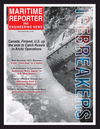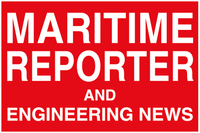
Page 20: of Maritime Reporter Magazine (November 2025)
Read this page in Pdf, Flash or Html5 edition of November 2025 Maritime Reporter Magazine
Legal Beat
Unlocking Capital from Goods on the Move
Through In-Transit Freight Financing
By J. Philip Nester, Benesch Law ecent history demonstrates just how unpredictable operational continuity without waiting for the cargo to arrive global supply chains can be, where delays, disrup- at their intended destination. In this way, in-transit freight ? - tions and prolonged transit times create substantial nancing transforms inventory from a cash-intensive asset into
Rcapital constraints for businesses. In-transit ? nanc- a resource that supports working capital needs of the business. ing can address these challenges by converting goods enroute
How In-Transit Financing Works into liquidity that enables businesses to sustain operations and pursue growth without interruption. In-transit ? nancing is structured to move in step with the
By combining negotiable bills of lading, structured credit supply chain. Once goods depart from a supplier or a port, arrangements and seasoned lending partners, businesses can a ? nancing partner assesses the shipment value in order to turn shipments into strategic ? nancial assets that scale with establish a borrowing base. In some cases, the base can be con? dence and strengthen resilience against supply chain un- combined with accounts receivable to create a ? exible line of certainties. In today’s interconnected and often unpredictable credit. Funding will be extended upfront to give the shipper global trade environment, in-transit ? nancing is more than a the ability to cover operational costs or manage concurrent source of capital – it is a strategic tool businesses can use to shipments while the goods remain in transit. Repayment of sustain operations, navigate risk and build long-term resil- the extended credit is timed with the delivery or sale of the ience. goods, which minimizes operational strain while protecting the lender’s collateral.
Converting Goods in Motion into
Important to this process is a negotiable master bill of lading (“MBL”). When issued “To the Order of” a lender or a des-
Working Capital
Global supply chains are longer, more complex and increas- ignated agent, the MBL operates as a negotiable instrument ingly unpredictable. For businesses managing shipments that that grants enforceable rights to the cargo. By contrast, house might be in transit for weeks, waiting for inventory to arrive bills of lading (“HBLs”) are often non-negotiable and issued before accessing capital can create signi? cant cash ? ow pres- to the shipper, which limits their utility to secure in-transit ? - sures. Traditional ? nancing structures through lines of credit, nancing. Proper coordination of service providers’ HBLs and loans or receivables often fail to align with transportation and MBLs, combined with tripartite agreements involving carri- logistics’ operational realities. In-transit freight ? nance can ers, forwarders, warehouses and customs brokers, ensures the address this gap and enable businesses to leverage inventories in-transit lender’s rights are recognized while maintaining the while enroute, thereby preserving liquidity and supporting un- uninterrupted ? ow of goods.
interrupted operations from origin to destination.
The Role of Specialty Lenders
Businesses that produce high-value goods or a high-volume
What Is In-Transit Freight Finance?
In-transit freight ? nance is a short-term working capital of shipments across complex supply chains stand to bene? t. solution that allows companies to draw on the value of in- Sectors such as retail, consumer goods, electronics and the ventory before reaching a consignee, warehouse or distribu- automotive industry, as well as companies navigating season- tion center. By converting shipments that are in-transit into al stock builds, just-in-time inventory models or unexpected ? nancial assets, businesses can bridge the period between the delays, can use in-transit ? nancing to preserve liquidity and purchase and delivery of those cargoes. This ? nancing tool is maintain operational momentum. Partnering with a specialty particularly relevant for enterprises that have long lead times, lender is a critical component of an effective in-transit ? nanc- high-volume imports or demand-driven inventory cycles. ing strategy. Experienced lenders structure solutions that ac-
Unlocking liquidity that is tied to goods that are in-transit, count for multi-modal transportation, ? uctuating delivery this ? nancing tool allows businesses to pay their suppliers, schedules and cross-border regulatory obligations. These manage costs associate with duties and tariffs, and maintain lenders can deliver scalable funding, responsive approval pro- 20 Maritime Reporter & Engineering News • November 2025
MR #11 (18-33).indd 20 MR #11 (18-33).indd 20 11/3/2025 1:46:47 PM11/3/2025 1:46:47 PM

 19
19

 21
21
